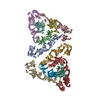+ データを開く
データを開く
- 基本情報
基本情報
| 登録情報 | データベース: PDB / ID: 7n69 | ||||||||||||||||||
|---|---|---|---|---|---|---|---|---|---|---|---|---|---|---|---|---|---|---|---|
| タイトル | Pre-fusion state 2 of EEEV with localized reconstruction | ||||||||||||||||||
 要素 要素 |
| ||||||||||||||||||
 キーワード キーワード | VIRUS / EEEV / pre-fusion / localized reconstruction | ||||||||||||||||||
| 機能・相同性 |  機能・相同性情報 機能・相同性情報togavirin / T=4 icosahedral viral capsid / symbiont-mediated suppression of host toll-like receptor signaling pathway / host cell cytoplasm / symbiont-mediated suppression of host gene expression / serine-type endopeptidase activity / fusion of virus membrane with host endosome membrane / symbiont entry into host cell / virion attachment to host cell / host cell nucleus ...togavirin / T=4 icosahedral viral capsid / symbiont-mediated suppression of host toll-like receptor signaling pathway / host cell cytoplasm / symbiont-mediated suppression of host gene expression / serine-type endopeptidase activity / fusion of virus membrane with host endosome membrane / symbiont entry into host cell / virion attachment to host cell / host cell nucleus / host cell plasma membrane / virion membrane / structural molecule activity / proteolysis / RNA binding / membrane 類似検索 - 分子機能 | ||||||||||||||||||
| 生物種 |   Eastern equine encephalitis virus (東部ウマ脳炎ウイルス) Eastern equine encephalitis virus (東部ウマ脳炎ウイルス) | ||||||||||||||||||
| 手法 | 電子顕微鏡法 / 単粒子再構成法 / クライオ電子顕微鏡法 / 解像度: 14.1 Å | ||||||||||||||||||
 データ登録者 データ登録者 | Chen, C.-L. / Kuhn, R.J. / Klose, T. | ||||||||||||||||||
| 資金援助 |  米国, 5件 米国, 5件
| ||||||||||||||||||
 引用 引用 |  ジャーナル: Proc Natl Acad Sci U S A / 年: 2022 ジャーナル: Proc Natl Acad Sci U S A / 年: 2022タイトル: Cryo-EM structures of alphavirus conformational intermediates in low pH-triggered prefusion states. 著者: Chun-Liang Chen / Thomas Klose / Chengqun Sun / Arthur S Kim / Geeta Buda / Michael G Rossmann / Michael S Diamond / William B Klimstra / Richard J Kuhn /  要旨: Alphaviruses can cause severe human arthritis and encephalitis. During virus infection, structural changes of viral glycoproteins in the acidified endosome trigger virus-host membrane fusion for ...Alphaviruses can cause severe human arthritis and encephalitis. During virus infection, structural changes of viral glycoproteins in the acidified endosome trigger virus-host membrane fusion for delivery of the capsid core and RNA genome into the cytosol to initiate virus translation and replication. However, mechanisms by which E1 and E2 glycoproteins rearrange in this process remain unknown. Here, we investigate prefusion cryoelectron microscopy (cryo-EM) structures of eastern equine encephalitis virus (EEEV) under acidic conditions. With models fitted into the low-pH cryo-EM maps, we suggest that E2 dissociates from E1, accompanied by a rotation (∼60°) of the E2-B domain (E2-B) to expose E1 fusion loops. Cryo-EM reconstructions of EEEV bound to a protective antibody at acidic and neutral pH suggest that stabilization of E2-B prevents dissociation of E2 from E1. These findings reveal conformational changes of the glycoprotein spikes in the acidified host endosome. Stabilization of E2-B may provide a strategy for antiviral agent development. | ||||||||||||||||||
| 履歴 |
|
- 構造の表示
構造の表示
| 構造ビューア | 分子:  Molmil Molmil Jmol/JSmol Jmol/JSmol |
|---|
- ダウンロードとリンク
ダウンロードとリンク
- ダウンロード
ダウンロード
| PDBx/mmCIF形式 |  7n69.cif.gz 7n69.cif.gz | 643.2 KB | 表示 |  PDBx/mmCIF形式 PDBx/mmCIF形式 |
|---|---|---|---|---|
| PDB形式 |  pdb7n69.ent.gz pdb7n69.ent.gz | 495.7 KB | 表示 |  PDB形式 PDB形式 |
| PDBx/mmJSON形式 |  7n69.json.gz 7n69.json.gz | ツリー表示 |  PDBx/mmJSON形式 PDBx/mmJSON形式 | |
| その他 |  その他のダウンロード その他のダウンロード |
-検証レポート
| 文書・要旨 |  7n69_validation.pdf.gz 7n69_validation.pdf.gz | 921.4 KB | 表示 |  wwPDB検証レポート wwPDB検証レポート |
|---|---|---|---|---|
| 文書・詳細版 |  7n69_full_validation.pdf.gz 7n69_full_validation.pdf.gz | 963 KB | 表示 | |
| XML形式データ |  7n69_validation.xml.gz 7n69_validation.xml.gz | 89.7 KB | 表示 | |
| CIF形式データ |  7n69_validation.cif.gz 7n69_validation.cif.gz | 145 KB | 表示 | |
| アーカイブディレクトリ |  https://data.pdbj.org/pub/pdb/validation_reports/n6/7n69 https://data.pdbj.org/pub/pdb/validation_reports/n6/7n69 ftp://data.pdbj.org/pub/pdb/validation_reports/n6/7n69 ftp://data.pdbj.org/pub/pdb/validation_reports/n6/7n69 | HTTPS FTP |
-関連構造データ
| 関連構造データ |  24201MC  7n6aC M: このデータのモデリングに利用したマップデータ C: 同じ文献を引用 ( |
|---|---|
| 類似構造データ | 類似検索 - 機能・相同性  F&H 検索 F&H 検索 |
- リンク
リンク
- 集合体
集合体
| 登録構造単位 | 
|
|---|---|
| 1 |
|
- 要素
要素
| #1: タンパク質 | 分子量: 47938.141 Da / 分子数: 6 / 由来タイプ: 組換発現 由来: (組換発現)  Eastern equine encephalitis virus (strain Florida 91-469) (ウイルス) Eastern equine encephalitis virus (strain Florida 91-469) (ウイルス)株: Florida 91-469 / 発現宿主:  Cricetinae gen. sp. (ネズミ) / 参照: UniProt: Q4QXJ7 Cricetinae gen. sp. (ネズミ) / 参照: UniProt: Q4QXJ7#2: タンパク質 | 分子量: 47046.953 Da / 分子数: 6 / 由来タイプ: 組換発現 由来: (組換発現)  Eastern equine encephalitis virus (strain Florida 91-469) (ウイルス) Eastern equine encephalitis virus (strain Florida 91-469) (ウイルス)株: Florida 91-469 / 発現宿主:  Cricetinae gen. sp. (ネズミ) / 参照: UniProt: Q4QXJ7 Cricetinae gen. sp. (ネズミ) / 参照: UniProt: Q4QXJ7Has protein modification | Y | |
|---|
-実験情報
-実験
| 実験 | 手法: 電子顕微鏡法 |
|---|---|
| EM実験 | 試料の集合状態: PARTICLE / 3次元再構成法: 単粒子再構成法 |
- 試料調製
試料調製
| 構成要素 | 名称: Eastern equine encephalitis virus / タイプ: VIRUS / Entity ID: all / 由来: RECOMBINANT | ||||||||||||||||||||||||||||||
|---|---|---|---|---|---|---|---|---|---|---|---|---|---|---|---|---|---|---|---|---|---|---|---|---|---|---|---|---|---|---|---|
| 分子量 | 実験値: NO | ||||||||||||||||||||||||||||||
| 由来(天然) | 生物種:   Eastern equine encephalitis virus (東部ウマ脳炎ウイルス) Eastern equine encephalitis virus (東部ウマ脳炎ウイルス) | ||||||||||||||||||||||||||||||
| 由来(組換発現) | 生物種:  Cricetinae gen. sp. (ネズミ) / 細胞: Baby hamster kidney cells Cricetinae gen. sp. (ネズミ) / 細胞: Baby hamster kidney cells | ||||||||||||||||||||||||||||||
| ウイルスについての詳細 | 中空か: NO / エンベロープを持つか: YES / 単離: STRAIN / タイプ: VIRION | ||||||||||||||||||||||||||||||
| 天然宿主 | 生物種: Equus caballus | ||||||||||||||||||||||||||||||
| ウイルス殻 | 直径: 660 nm | ||||||||||||||||||||||||||||||
| 緩衝液 | pH: 5.5 / 詳細: pH 5.5 | ||||||||||||||||||||||||||||||
| 緩衝液成分 |
| ||||||||||||||||||||||||||||||
| 試料 | 濃度: 0.2 mg/ml / 包埋: NO / シャドウイング: NO / 染色: NO / 凍結: YES 詳細: Estimate E2 protein concentration by SDS-PAGE with BSA ranging from 0.1 to 1 microgram. | ||||||||||||||||||||||||||||||
| 試料支持 | 詳細: 25 mA / グリッドの材料: COPPER グリッドのタイプ: PELCO Ultrathin Carbon with Lacey Carbon | ||||||||||||||||||||||||||||||
| 急速凍結 | 装置: GATAN CRYOPLUNGE 3 / 凍結剤: ETHANE / 湿度: 80 % / 凍結前の試料温度: 298 K / 詳細: blot for 3.3 seconds before plunging |
- 電子顕微鏡撮影
電子顕微鏡撮影
| 実験機器 |  モデル: Titan Krios / 画像提供: FEI Company |
|---|---|
| 顕微鏡 | モデル: FEI TITAN KRIOS |
| 電子銃 | 電子線源:  FIELD EMISSION GUN / 加速電圧: 300 kV / 照射モード: FLOOD BEAM FIELD EMISSION GUN / 加速電圧: 300 kV / 照射モード: FLOOD BEAM |
| 電子レンズ | モード: BRIGHT FIELD / 倍率(公称値): 81000 X / Cs: 2.7 mm / C2レンズ絞り径: 100 µm |
| 試料ホルダ | 凍結剤: NITROGEN 試料ホルダーモデル: FEI TITAN KRIOS AUTOGRID HOLDER 最低温度: 100 K |
| 撮影 | 電子線照射量: 32 e/Å2 / 検出モード: SUPER-RESOLUTION フィルム・検出器のモデル: GATAN K2 SUMMIT (4k x 4k) 撮影したグリッド数: 1 |
- 解析
解析
| EMソフトウェア |
| ||||||||||||||||||||||||||||||||||||
|---|---|---|---|---|---|---|---|---|---|---|---|---|---|---|---|---|---|---|---|---|---|---|---|---|---|---|---|---|---|---|---|---|---|---|---|---|---|
| CTF補正 | タイプ: PHASE FLIPPING AND AMPLITUDE CORRECTION | ||||||||||||||||||||||||||||||||||||
| 対称性 | 点対称性: C1 (非対称) | ||||||||||||||||||||||||||||||||||||
| 3次元再構成 | 解像度: 14.1 Å / 解像度の算出法: FSC 0.143 CUT-OFF / 粒子像の数: 192060 / アルゴリズム: BACK PROJECTION 詳細: 192060 asymmetric units were used for reconstruction 対称性のタイプ: POINT | ||||||||||||||||||||||||||||||||||||
| 原子モデル構築 | プロトコル: FLEXIBLE FIT / 空間: REAL | ||||||||||||||||||||||||||||||||||||
| 原子モデル構築 | PDB-ID: 6MX4 Accession code: 6MX4 / Source name: PDB / タイプ: experimental model |
 ムービー
ムービー コントローラー
コントローラー









 PDBj
PDBj



